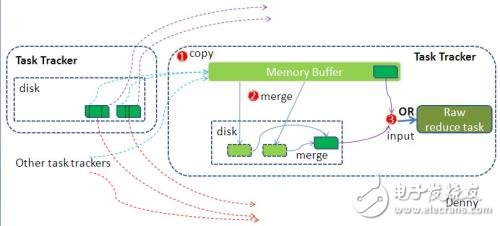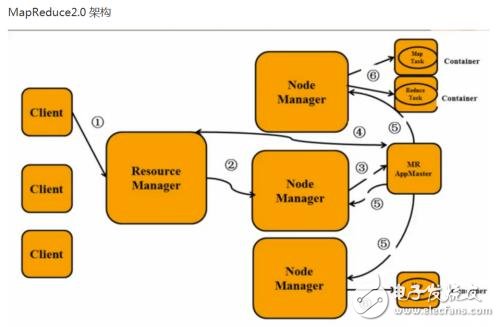

mapreduce二次排序_ mapreduce二次排序原理
编程语言及工具
描述
关于什么是二次排序
在mapreduce操作时,shuffle阶段会多次根据key值排序。但是在shuffle分组后,相同key值的values序列的顺序是不确定的(如下图)。如果想要此时value值也是排序好的,这种需求就是二次排序。
默认情况下,Map输出的结果会对Key进行默认的排序,但是有时候需要对Key排序的同时还需要对Value进行排序,这时候就要用到二次排序了。
mapreduce二次排序分析
我们把二次排序分为以下几个阶段
Map起始阶段
在Map阶段,使用job.setInputFormatClass()定义的InputFormat,将输入的数据集分割成小数据块split,同时InputFormat提供一个RecordReader的实现。在这里我们使用的是TextInputFormat,它提供的RecordReader会将文本的行号作为Key,这一行的文本作为Value。这就是自定 Mapper的输入是《LongWritable,Text》 的原因。然后调用自定义Mapper的map方法,将一个个《LongWritable,Text》键值对输入给Mapper的map方法
Map最后阶段
在Map阶段的最后,会先调用job.setPartitionerClass()对这个Mapper的输出结果进行分区,每个分区映射到一个Reducer。每个分区内又调用job.setSortComparatorClass()设置的Key比较函数类排序。可以看到,这本身就是一个二次排序。如果没有通过job.setSortComparatorClass()设置 Key比较函数类,则使用Key实现的compareTo()方法
Reduce阶段
在Reduce阶段,reduce()方法接受所有映射到这个Reduce的map输出后,也会调用job.setSortComparatorClass()方法设置的Key比较函数类,对所有数据进行排序。然后开始构造一个Key对应的Value迭代器。这时就要用到分组,使用 job.setGroupingComparatorClass()方法设置分组函数类。只要这个比较器比较的两个Key相同,它们就属于同一组,它们的 Value放在一个Value迭代器,而这个迭代器的Key使用属于同一个组的所有Key的第一个Key。最后就是进入Reducer的 reduce()方法,reduce()方法的输入是所有的Key和它的Value迭代器,同样注意输入与输出的类型必须与自定义的Reducer中声明的一致。
 、
、
#p##e#
接下来我们通过示例,可以很直观的了解二次排序的原理
输入文件 sort.txt 内容为
40 20
40 10
40 30
40 5
30 30
30 20
30 10
30 40
50 20
50 50
50 10
50 60
输出文件的内容(从小到大排序)如下
30 10
30 20
30 30
30 40
--------
40 5
40 10
40 20
40 30
--------
50 10
50 20
50 50
50 60
从输出的结果可以看出Key实现了从小到大的排序,同时相同Key的Value也实现了从小到大的排序,这就是二次排序的结果
mapreduce二次排序的具体流程
在本例中要比较两次。先按照第一字段排序,然后再对第一字段相同的按照第二字段排序。根据这一点,我们可以构造一个复合类IntPair ,它有两个字段,先利用分区对第一字段排序,再利用分区内的比较对第二字段排序。二次排序的流程分为以下几步。
1、自定义 key
所有自定义的key应该实现接口WritableComparable,因为它是可序列化的并且可比较的。WritableComparable 的内部方法如下所示
// 反序列化,从流中的二进制转换成IntPairpublic void readFields(DataInput in) throws IOException
// 序列化,将IntPair转化成使用流传送的二进制public void write(DataOutput out)
// key的比较public int compareTo(IntPair o)
// 默认的分区类 HashPartitioner,使用此方法public int hashCode()
// 默认实现public boolean equals(Object right)
2、自定义分区
自定义分区函数类FirstPartitioner,是key的第一次比较,完成对所有key的排序。
public static class FirstPartitioner extends Partitioner《 IntPair,IntWritable》
在job中使用setPartitionerClasss()方法设置Partitioner
job.setPartitionerClasss(FirstPartitioner.Class);
3、Key的比较类
这是Key的第二次比较,对所有的Key进行排序,即同时完成IntPair中的first和second排序。该类是一个比较器,可以通过两种方式实现。
1) 继承WritableComparator。
public static class KeyComparator extends WritableComparator
必须有一个构造函数,并且重载以下方法。
public int compare(WritableComparable w1, WritableComparable w2)
2) 实现接口 RawComparator。
上面两种实现方式,在Job中,可以通过setSortComparatorClass()方法来设置Key的比较类。
job.setSortComparatorClass(KeyComparator.Class);
注意:如果没有使用自定义的SortComparator类,则默认使用Key中compareTo()方法对Key排序。
4、定义分组类函数
在Reduce阶段,构造一个与 Key 相对应的 Value 迭代器的时候,只要first相同就属于同一个组,放在一个Value迭代器。定义这个比较器,可以有两种方式。
1) 继承 WritableComparator。
public static class GroupingComparator extends WritableComparator
必须有一个构造函数,并且重载以下方法。
public int compare(WritableComparable w1, WritableComparable w2)
2) 实现接口 RawComparator。
上面两种实现方式,在 Job 中,可以通过 setGroupingComparatorClass()方法来设置分组类。
job.setGroupingComparatorClass(GroupingComparator.Class);
另外注意的是,如果reduce的输入与输出不是同一种类型,则 Combiner和Reducer 不能共用 Reducer 类,因为 Combiner 的输出是 reduce 的输入。除非重新定义一个Combiner。
3、代码实现
Hadoop的example包中自带了一个MapReduce的二次排序算法,下面对 example包中的二次排序进行改进
package com.buaa;
import java.io.DataInput;
import java.io.DataOutput;
import java.io.IOException;
import org.apache.hadoop.io.WritableComparable;
/**
* @ProjectName SecondarySort
* @PackageName com.buaa
* @ClassName IntPair
* @Description 将示例数据中的key/value封装成一个整体作为Key,同时实现 WritableComparable接口并重写其方法
* @Author 刘吉超
* @Date 2016-06-07 22:31:53
*/
public class IntPair implements WritableComparable《IntPair》{
private int first;
private int second;
public IntPair(){
}
public IntPair(int left, int right){
set(left, right);
}
public void set(int left, int right){
first = left;
second = right;
}
@Override
public void readFields(DataInput in) throws IOException{
first = in.readInt();
second = in.readInt();
}
@Override
public void write(DataOutput out) throws IOException{
out.writeInt(first);
out.writeInt(second);
}
@Override
public int compareTo(IntPair o)
{
if (first != o.first){
return first 《 o.first ? -1 : 1;
}else if (second != o.second){
return second 《 o.second ? -1 : 1;
}else{
return 0;
}
}
@Override
public int hashCode(){
return first * 157 + second;
}
@Override
public boolean equals(Object right){
if (right == null)
return false;
if (this == right)
return true;
if (right instanceof IntPair){
IntPair r = (IntPair) right;
return r.first == first && r.second == second;
}else{
return false;
}
}
public int getFirst(){
return first;
}
public int getSecond(){
return second;
}
}
package com.buaa;
import java.io.IOException;import java.util.StringTokenizer;
import org.apache.hadoop.conf.Configuration;import org.apache.hadoop.fs.FileSystem;import org.apache.hadoop.fs.Path;import org.apache.hadoop.io.IntWritable;import org.apache.hadoop.io.LongWritable;import org.apache.hadoop.io.Text;import org.apache.hadoop.io.WritableComparable;import org.apache.hadoop.io.WritableComparator;import org.apache.hadoop.mapreduce.Job;import org.apache.hadoop.mapreduce.Mapper;import org.apache.hadoop.mapreduce.Partitioner;import org.apache.hadoop.mapreduce.Reducer;import org.apache.hadoop.mapreduce.lib.input.FileInputFormat;import org.apache.hadoop.mapreduce.lib.input.TextInputFormat;import org.apache.hadoop.mapreduce.lib.output.FileOutputFormat;import org.apache.hadoop.mapreduce.lib.output.TextOutputFormat;
/**
* @ProjectName SecondarySort
* @PackageName com.buaa
* @ClassName SecondarySort
* @Description TODO
* @Author 刘吉超
* @Date 2016-06-07 22:40:37*/
@SuppressWarnings(“deprecation”)public class SecondarySort {
public static class Map extends Mapper《LongWritable, Text, IntPair, IntWritable》 {
public void map(LongWritable key, Text value, Context context) throws IOException, InterruptedException {
String line = value.toString();
StringTokenizer tokenizer = new StringTokenizer(line);
int left = 0;
int right = 0;
if (tokenizer.hasMoreTokens()) {
left = Integer.parseInt(tokenizer.nextToken());
if (tokenizer.hasMoreTokens())
right = Integer.parseInt(tokenizer.nextToken());
context.write(new IntPair(left, right), new IntWritable(right));
}
}
}
/*
* 自定义分区函数类FirstPartitioner,根据 IntPair中的first实现分区
*/
public static class FirstPartitioner extends Partitioner《IntPair, IntWritable》{
@Override
public int getPartition(IntPair key, IntWritable value,int numPartitions){
return Math.abs(key.getFirst() * 127) % numPartitions;
}
}
/*
* 自定义GroupingComparator类,实现分区内的数据分组
*/
@SuppressWarnings(“rawtypes”)
public static class GroupingComparator extends WritableComparator{
protected GroupingComparator(){
super(IntPair.class, true);
}
@Override
public int compare(WritableComparable w1, WritableComparable w2){
IntPair ip1 = (IntPair) w1;
IntPair ip2 = (IntPair) w2;
int l = ip1.getFirst();
int r = ip2.getFirst();
return l == r ? 0 : (l 《 r ? -1 : 1);
}
}
public static class Reduce extends Reducer《IntPair, IntWritable, Text, IntWritable》 {
public void reduce(IntPair key, Iterable《IntWritable》 values, Context context) throws IOException, InterruptedException {
for (IntWritable val : values) {
context.write(new Text(Integer.toString(key.getFirst())), val);
}
}
}
public static void main(String[] args) throws IOException, InterruptedException, ClassNotFoundException {
// 读取配置文件
Configuration conf = new Configuration();
// 判断路径是否存在,如果存在,则删除
Path mypath = new Path(args[1]);
FileSystem hdfs = mypath.getFileSystem(conf);
if (hdfs.isDirectory(mypath)) {
hdfs.delete(mypath, true);
}
Job job = new Job(conf, “secondarysort”);
// 设置主类
job.setJarByClass(SecondarySort.class);
// 输入路径
FileInputFormat.setInputPaths(job, new Path(args[0]));
// 输出路径
FileOutputFormat.setOutputPath(job, new Path(args[1]));
// Mapper
job.setMapperClass(Map.class);
// Reducer
job.setReducerClass(Reduce.class);
// 分区函数
job.setPartitionerClass(FirstPartitioner.class);
// 本示例并没有自定义SortComparator,而是使用IntPair中compareTo方法进行排序 job.setSortComparatorClass();
// 分组函数
job.setGroupingComparatorClass(GroupingComparator.class);
// map输出key类型
job.setMapOutputKeyClass(IntPair.class);
// map输出value类型
job.setMapOutputValueClass(IntWritable.class);
// reduce输出key类型
job.setOutputKeyClass(Text.class);
// reduce输出value类型
job.setOutputValueClass(IntWritable.class);
// 输入格式
job.setInputFormatClass(TextInputFormat.class);
// 输出格式
job.setOutputFormatClass(TextOutputFormat.class);
System.exit(job.waitForCompletion(true) ? 0 : 1);
}
}

-
二次谐波和三次谐波区别 二次谐波危害没有三次谐波大?2024-04-08 12026
-
什么是二次回路?二次回路的分类 辨识二次回路2023-12-13 8830
-
什么是二次回路?二次回路的分类有哪些?二次回路抗干扰措施2023-11-20 5658
-
二次电池的特征 一次电池与二次电池的区别2023-11-17 4451
-
什么是二次锂电池组?一次电池和二次电池区别2022-12-02 7289
-
如何看二次回路图2022-08-29 5269
-
二次锂电池组是什么,一次电池和二次电池的区别2020-11-13 16802
-
二次电池是什么_二次电池有哪些_二次电池充放电方程式2018-02-02 25092
-
MaxCompute MapReduce2018-01-31 3712
-
AutoCAD VBA二次开发教程2015-11-02 1786
-
新型二次电池材料2010-09-12 917
-
什么是二次谐波?二次谐波的定义?2009-11-14 14980
-
二次电池的特性和应用2009-05-24 2592
-
二次电池及充电FAQ2008-09-07 679
全部0条评论

快来发表一下你的评论吧 !

